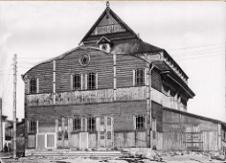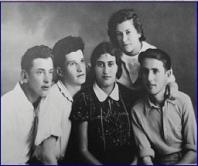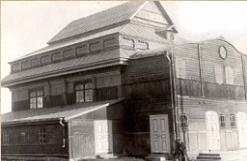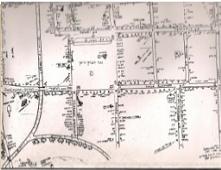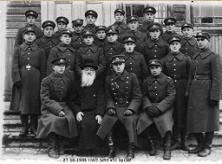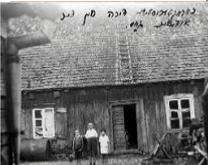VILKAVISKIS
A small town in Southern Lithuania
Where the Jewish Community is no more
Shtetl Life
Education
Jewish Vocational School Vilkaviskis
Graduation class of a vocational school, Vilkaviskis, Lithuania 1934
Since 1931 Here you are allowed to set up a Trade School. On the first floor, where there is now the Civil Registry Office, there were a lot of different machines, Jewish students were studying there, where Municipal servants are now walking. Here they were trained in various occupations to earn a living.
From the very beginning, the three-year boys' training course belonged to the Haskalah Va'avoda Jewish community. 1937 In October, they were taken over by the Craftsmen's Society (then the association called ORT, in Russian - the Society of Handicraft Work) Vilkaviškis branch. A year later, a permission was received for the establishment of a girls' section. Then the course was renamed and became the sales associate of the Vilkaviškis Association of Three Years. The educational institution has acquired all the necessary machinery, tools and equipment. The institution was flourishing and had a lot of students.
From an article in the Vilkaviskis newspaper Santaka
Images from the Vilkaviskis Jewish Vocational School
ORT Vilkaviskis Official stamp
he image of the man using the drill is am image is from the ORT archive but does not originate in Vilkaviskis. The location is unknown but from the man’s clothing it is clear that this was far earlier than the late 1930s when ORT was active in Vilkaviskis
Closure of ORT in 1940
At the beginning of the first Soviet occupation, from 1 July 1940, the Lithuanian Minister of the Interior banned all non-communist organization's (public, cultural, religious) in the
country in the “interest of security”. The same day the leadership of ORT sent a request to the Minister asking him to let ORT and its chapters in the provinces continue their activities.
They attached a list of the organization's board members. Having read the list, the Minister decided to remove the Chairman Abelis Jodidio and other members as unacceptable to the new communist regime. A new board was to be formed over a period of six months. He appointed Benjaminas Soloveičikas to be in charge of current affairs and funds, and allowed the organization and its chapters to continue their activities. Despite Soloveičikas’ efforts to form a new board, a month later, on 6 August 1940, the Interior Minister issued a resolution to close the Organization for the Advancement of Skilled Trades and Agricultural Labour among Jews in Lithuania, ORT, and its chapters. He based his decision on the grounds that “under the present circumstances further activities of the organization were no longer compatible with state security”.
These pictures are taken from an exhibition prepared by ORT and displayed at the Lithuanian Parliament as part of the 4th Litvak International Congress in Vilnius, September 2013
Pictures used by kind permission of Rachel Bracha, Archive Coordinator, World Ort and Dr.Kamile Rupeikaite of the Vilna Gaon State Jewish Museum
Diploma for Issac Finkelstein
From June 1931, a three-year course for boys in metalworking run by the town’s Haskalah Va’avoda was offered in Vilkaviškis. In October 1937 it was taken over by the ORT Vilkaviškis branch. In September 1938 permission was received to open a dressmaking section for girls.
It was then renamed and became the ORT Vilkaviškis three-year trade course. It was run according to the statutes and programme signed by the Education Minister in the society’s building, which had been purpose-built for the course.It had all the necessary modern machines, tools and equipment.
The course did not differ from a vocational school: students over 14 with primary education were admitted; studies lasted for three years;not only special, but also general subjects were taught.
The ORT Vilkaviškis branch, the World ORT Central Committee in Paris, and donations from individuals financed the courses; the tuition feesand income earned from fulfilled external orders were also used to fund it.In 1939 the course was led by Samuelis Eidelsas, who was educated at Brno High Technical School; he also worked as a lecturer. Other lecturers were Alfonsas Ulčinas, Abromas Streleckis, Sara Faktorovskytė, Giršas Levinsonas, Bašė Šamborskytė and others.
In 1940 the courses were attended by 40 students: 24 in metalworking and 16 girls in sewing.On 1 September 1940, the People’s Education Commissar of Soviet Lithuania ordered the courses to be closed; it happened three weeks after ORT activities were banned.
In Vilkaviskis the school was situated on the ground floor of the building that housed the Jewish High School









